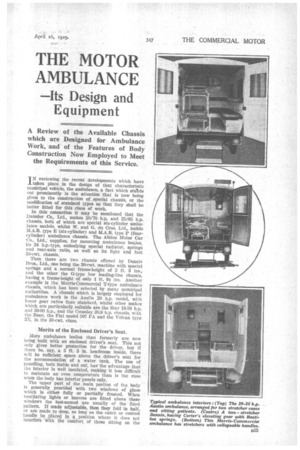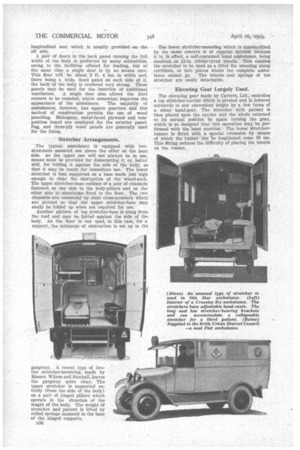THE MOTOR AMBULANCE
Page 141

Page 142

Page 143

If you've noticed an error in this article please click here to report it so we can fix it.
Its Design and Equipment
TN reviewing the recent developments which have 'taken place in the design of that characteristic municipal vehicle, the ambulance, a fact which steals out prominently is the attention that is now being given to the construction of special chassis, or the modification of standard types so that they shall be better fitted for this class of work.
In this connection it may be mentioned that the Daimler Co., Ltd., makes 20/70 h.p. and 25/85 h.p. chassis, both of which are special six-cylinder ambulance models, whilst W. and G. du Cros, Ltd., builds M.A.B. type E (six-cylinder) and M.A.B. type P (fourcylinder) ambulance chassis. The Albion Motor Car Co., Ltd., supplies, for mounting ambulance bodies, its 24 h.p.-type, embodying special radiator, springs and rear-axle ratio, as well as its light and fast 30-cwt. chassis.
Then there are two chassis offered by Dennis Bros., Ltd. one being the 30-cwt. machine with special springs arid a normal frame-height of 2 ft. 3 ins., and the other the G-type low loading-line chassis, baying a frame-height of only 1 ft. 9i ins. Another example is the Morris-Commercial T-type ambulance chassis, which has been selected by many municipal authorities. A chassis which is largely employed for ambulance work is the Austin 20 h.p. model, with lower gear ratios than standard, whilst other makes which are particularly, suitable are the Star 18-50 h.p.
and 20-60 and the Cressley 20.9 h.p. chassis, with the Bean, the Fiat model .507 FA and the Vulcan type 3X, in the 30-cwt. class.
Merits of the Enclosed Driver's Seat.
More ambulance bodies than formerly are now being built with an enclosed driver's seat. This not only gives better protection for the driver, but if there be, say, a 5 ft. 3 in, headroom inside, there will be sufficient space above the driver's seat for tile accommodation of a water tank. The use of panelling, both inside and out, has the advantage that the interior is well insulated, making it less difficult to maintain an even temperature than is the case when the body has interior panels only.
The upper part of the . main portion of the body is generally provided with two windows of glass which is either fully or partially frosted. When ventilating lights or louvres are fitted above these windows the last-named are usually of the fixed. pattern. If made adjustable, then they fold in half, or are made to drop, so long as the catch or control handle be .phiced iiia position where it does not interfere With the comfort of those sitting on the•
longitudinal seat which is usually provided on the off side.
A pair of doors in the back panel opening the full width of the body is preferred by many authorities, owing to the facilities orrered for loading, but at the same time a single door is by no means rare. This door will be about 3 ft. 4 ins, in width and, there being a wide, fixed panel on each side of it, the back of the body is rendered very strong. These panels may be used for the insertion of additional ventilators. A single door also allows the hind corners to be rounded, which somewhat improves the appearance of the ambulance. The majority of ambulances, however, has square quarters and this method of construction permits the use of wood panelling. Mahogany, metal-faced plywood and composition board are employed for the exterior panelling, and three-ply wood panels are generally used for the lining.
• Stretcher Arrangements.
The typical ambulance is equipped with two stretchers mounted one above the other on the near side. As the upper one will not always be in use, means must be provided for dismounting it, or, better still, for folding it against the side of the body, so that it may he ready for immediate use. The lower stretcher is best supported on a base made just high enough to clear the obstruction of the wheel-arch. The upper stretcher-base consists of a pair of channels fastened on one side to the body-pillars and on the other side to• stanchions fixed to the floor. The two channelsare connected by steel cross-members which are pivoted so that the upper stretcher-base may easily be folded up when not required for use. • Another pattern of top stretcher-base is slung from the roof and may be folded against the side of the body. As the floor is not used, in this case, for a support, ,the minimum of obstruction is set up in the gangway. A recent type of twotier stretcher-mounting, made by Messrs. Wilson and Stockall, leaves the gangway quite clear. The upper stretcher is supported entirely (from the side of the body) on a pair of hinged pillars which operate in the direction of the length of the body. The weight of stretcher and patient is lifted by coiled springs mounted in the base of the hinged supports.
D56
The lower stretchtr-mounting which is standardized by the same concern is of especial iittereit because it is, iii effect, a self-contained hand ambulance, being mounted on .12-in. rubber-tyred wheels. This enables the stretcher to be used as a litterfor wheeling along corridors, or into places' where the complete ambu
lance cannot, go. The wheels and springs of the stretcher are easily detachable.
Elevating Gear Largely Used.
The elevating gear made by Carters, Ltd., embodies a top stretcher-carrier which is pivoted and is loWered outwards to any convenient height by a few turns of a silent hand-gear. The stretcher'. with patient is then placed upon the carrier and the whole returned to its normal position by •again turning the gear, which is so designed that this operation may be performed with the least exertion. The lower stretcherrunner, is fitted with a special extension by means of which the -runner-cEin be 'lengthened some 18 ins. This fitting reduces the difficulty of placing the wheels on the. runner,
Carters elevating gear is made up also as a selfcontained unit, so that it may be removed and the vehicle used for other purposog. The stretcher carriers may also be mounted on Carters' Rastilon suspension springs. These are fitted transversely and are designed to give great resilience, whether the patient be light or heavy.
With the normal mounting of the stretcher entirely behind the driving seat, a chassis having a wheelbase of about 11 ft. is required. If use is to be made of a shorter vehicle, then a single lower stretcher may be accommodated on the near side by enclosing a space beside the driver and incorporating it with the main portion of the body. A short-wheelbase ambulance should be easy to manceuvre in crowded or narrow streets, or in the confined spaces where accidents may occur. It is suggested that a forwardcontrol type of chassis might be designed with this ohlect in view. Although all ambulance bodies should be made so that they may be easily cleaned and disinfected, this feature should be specially studied when the vehicle is used for carrying fever patients. All sharp corners should be filled in with rounded fillets and the stretcher covered with a wire mesh or steel sheet; the stretcher-frame also ought to be made of metal.
The length of the body required depends to a great extent on the pattern of stretcher adopted. Stretchers with fixed handles vary from 7 ft. 6 ins. to 7 ft. 0 ills. in length, but if telescopic handles be provided the length may be reduced to 6 ft. 4 ins. or 6 ft. 5 ins. Stretchers are often meunted on each side of the
central gangway. If the ambulance be thus equipped, then it will be an advantage if one side of the body eaa be converted for sitting cases. There is no difficulty, as a rule, in placing a seat-cushion on top of the stretcher-base, provided it has no permanent upper structure carrying a top stretcher.
With the introduction of pneumatic upholstery the provision of hygienic cushions and backrests—for the patients and attendant as well as for the driver-Is simplified.








































































































































































































